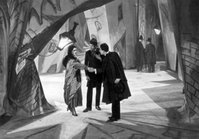
LEONARDO'S WAY OF TEACHING ANATOMY
One of the easiest ways to learn anatomy is to relate function with structure. Quite often, the anatomy is intimately connected to its function. Evolution has produced the most efficient structure for the maximum performance of the body. However, bodies are under constant change and as researchers look back at the history of the human, many structures have disappeared or become more prominent.
Leonardo’s originality as an anatomist is best revealed through his drawings and descriptions accompanying each of them. He did not believe in the use of too many words to describe his ideas. The few words he used were directly related to the drawings and expressed mechanical and technical ideas. For instance, he referred to muscles with words such as “springs” and “wires” in order to convey the idea of a machine.


The wires or cords are to indicate the lines of tension developed by the muscles as shown by his words:“...Make this leg in full relief, and make the cords of tempered copper, and then bend them according to their natural form. After doing this you will be able to draw them from 4 sides. Place them as they exist in nature, and speak of their uses.“
Leonardo's approach, with its notions of layers, levels, transparency, cutaways, sections opens up the body in a new way. Surface features and below the surface features are now integrated into the same process of understanding. But at the same time there is a curious way in which the new methods of visualization lead to a process of externalization: everything can be seen, brought out into the open, not just the insides of arms and legs, but also the inner organs and even the inner expressions of the mind and soul. There is a new belief that everything can be brought to the surface. Hence the study of anatomy, art and an early form of psychology emerge together in Leonardo's notebooks(Dr. Kim H. Veltman)

As a mathematical supplement, Leonardo’s detailed measures of every single part of the body emphasized his desire to normalize the human body. This calculated approach could relate to an eventual plan to create a human machine.(S.Pestieau)
Leonardo on the Human Body
Leonardo Da Vinci's anatomical drawings, due to his extreme curiosity, became one of his most profound works to date. Published by Dover from the original text 1952. The book is set up in 2 columns and broken up into headers of different anatomical structures; either of bones, muscles, ventricles of the heart or brains. The chapters are broken into systems: nervous, cardiovascular, myological, osteological, respitory, alimentary and others. Within the text there are italicized words. These are the words written on the drawing itself, in Leonardo's usual backward writing style.
Some of you might be curious, beyond the drawings themselves to read what Leonardo thought at the time. And from there is the authors commentary. For those interested in anatomy, drawing, painting or anything in the art field, this book is highly recommended, for it has limitless reference value. I continually look at it for my drawings. One will also notice that many of the "models" are of the same body or person. This is because Leonardo asked a friend on his deathbed if he could cut him up, dissect him and then draw him. The friend, of course, consented to this, and so we have Leonardo's masterpiece.
More Links
Anatomy Image BankWeb Anatomy AndrewLoomis AnatomyPhoto Reference on Human Anatomy























